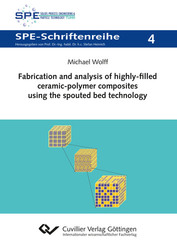| Departments | |
|---|---|
| Book Series (96) |
1378
|
| Nachhaltigkeit |
3
|
| Gesundheitswesen |
1
|
| Humanities |
2364
|
| Natural Sciences |
5406
|
| Engineering |
1793
|
| Engineering | 292 |
| Mechanical and process engineering | 862 |
| Electrical engineering | 686 |
| Mining and metallurgy | 30 |
| Architecture and civil engineering | 75 |
| Common |
98
|
|
Leitlinien Unfallchirurgie
5. Auflage bestellen |
|
Advanced Search
Fabrication and analysis of highly-filled ceramic-polymer composites using the spouted bed technology (Volume 4) (English shop)
Michael Wolff (Author)Preview
Table of Contents, PDF (120 KB)
Extract, PDF (640 KB)
In this thesis a versatile process route for the fabrication of novel bulk composite materials is developed, which is based on the spouted bed spray granulation process. The granulation process is used to assemble different kinds and sizes of ceramic particles and polymers into granules. In this process a liquid, which contains organic (and sometimes inorganic) components, is sprayed onto fluidized particles. The key advantages of the spouted bed spray granulation process are analyzed with respect to the fabrication of novel composite materials, and several process routes for different types of polymers and different target properties are developed. The granules are further processed to dense composites, which are then analyzed with respect to their morphology and mechanical properties. It is also shown that this process route can be combined with other processes to fabricate composites with a genuine hierarchical structure. The inner structure and the mechanical properties of the final composites are analyzed and simulated with the Discrete-Element-Method (DEM). It is shown that the DEM is a very useful and adequate simulation tool for the fabricated composites, particularly for composites with a high filling degree, as it allows a direct three-dimensional representation of the composite.
| ISBN-13 (Hard Copy) | 9783736991378 |
| ISBN-13 (eBook) | 9783736981379 |
| Final Book Format | B5 |
| Language | English |
| Page Number | 184 |
| Edition | 1. Aufl. |
| Book Series | SPE-Schriftenreihe |
| Volume | 4 |
| Publication Place | Göttingen |
| Place of Dissertation | Hamburh-Harburg |
| Publication Date | 2015-11-12 |
| General Categorization | Dissertation |
| Departments |
Mechanical and process engineering
|
| Keywords | spouted bed, granulation, composites, DEM |








